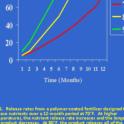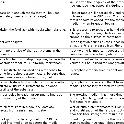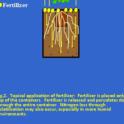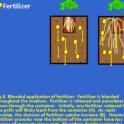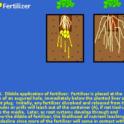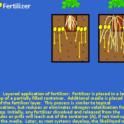The use of controlled-release fertilizers (CRF) as part of a Best Management Program (BMP) to improve nutrient uptake efficiency and mitigate nutrient runoff
by Donald Merhaut
Solid fertilizers include granules, prills, crystals and powders. A prilled fertilizer is a type of granular fertilizer that is nearly spherical made by solidifying free-falling droplets in air or a fluid medium. Most controlled-release fertilizers (CRFs) used in commercial nurseries are prilled fertilizers that have been coated with sulfur or a polymer. These products have been developed to allow a slow release of nutrients into the root zone throughout crop development. In the following article we will describe several characteristics of CRFs that should be understood and various cultural practices that should be implemented to optimize nutrient use and minimize nutrient leaching when CRFs are part of a fertilization program.
How controlled-release fertilizers work
Nutrients are released out of coated fertilizer prills through osmosis at a rate that is positively correlated with increased temperature. The release rates are associated with the type and/or thickness of the coating on the fertilizer prill granule. Different manufacturers estimate the nutrient release rates of their products under different temperature regimes. For example, some manufacturers test release rates of their products at a constant temperature of 70°F, while other manufacturers test release rates at a constant temperature of 82°F. Most manufacturers test at a constant temperature between 70-82°F. If temperatures go above these thresholds, nutrient release rates are faster and product longevity (length of time some available fertilizer remains in the coated granule) decreases (fig. 1). Likewise, if temperatures are below these thresholds, the nutrient release rates slow down, but the longevity of the products is longer.
CRF products available - longevities
CRF fertilizers are available with different longevities. Most manufacturers have products with 3, 6, 9, or 12-month release periods. Products with different longevities are manufactured by blending fertilizer prills of different coating thicknesses: the thinner coated prills release nutrients first and then the thicker-coated prills release nutrients later. Short- term crops such as annuals would probably require 3-month release products and longer-term crops such as woody perennials would require fertilizer products with a 12-month release period. Keep in mind that if the nursery production facility is near the cooler coast, fertilizer release rates will be slower and the CRF will last longer. Likewise, for hot inland climates, CRFs may release quickly and last for a shorter duration.
Cultural practices
Various cultural practices related to the use of fertilizers such as fertilizer application, irrigation, and fertilizer and soil/substrate storage are described below. It is important that certain Best Management Practices (BMPs) are implemented when using fertilizers to prevent off-site movement in runoff water or leaching into groundwater. BMPs associated with these cultural practices and the rationales for implementation are summarized in Table 1.
Application methods. The CRFs can be added to containers via four methods: (1) topical application, (2) blended into media, (3) dibble, and (4) layered. The primary focus of the application method should be to optimize fertilizer release from the prills in proximity to actively growing roots.
Topical applications (fig. 2) apply the CRFs to the surface of the containers either by hand or by a spreader. With this cultural practice, the fertilizer is released from the prills and the nutrients will move down into the root zone. Close-spacing of containers during topical application is important to prevent fertilizer spillage between containers.
Blending into media (fig. 3) can be done, especially if a medium is custom blended. In this process, the fertilizer prills are uniformly mixed into the media and fertilizer is released throughout the medium. It is important to minimize direct fertilizer contact with blades and mixers to prevent prill cracking which can lead to fertilizer leakage.
Dibble applications (fig. 4) are done by adding a premeasured amount of CRF into holes augured into containers during the canning process. The plant liner or plug is then placed into the hole. If automated, this process can save time, money and increase crop uniformity.
Layer applications (fig. 5) are done by adding media to a container part way, then spreading the CRF to the container, adding the plant plug or liner, and adding media to the rest of the container. The use of layer applications is a BMP used in humid climates to prevent nitrogen volatilization that can especially occur when CRFs are spread on the surface of containers.
Irrigation programs. Even though CRFs offer slow release of fertilizers and can mitigate nutrient runoff, improper irrigation practices can leach nutrients past the root zone, increasing the possibility of nutrient runoff. Therefore, the BMPs listed in table 1 should be practiced; otherwise, the benefits of using CRFs are lost. It is important that the growing medium is uniformly moistened without over-irrigation. In addition, the use of wetting agents is recommended for hydrophobic media such as peat. Another BMP that can promote uniform wetting of the media is the use of pulse irrigation. Pulse irrigation can apply the same total amount of water as conventional application but in multiple, smaller applications. The pulse irrigation first provides water that pre-moistens the medium. Subsequent irrigation cycles later provide easy, uniform absorption of water from the already pre-moistened substrate.
Fertilizer and soil/substrate storage. Even though the fertilizer in CRFs is coated in a polymer or sulfur coating, improper storage can still result in fertilizer loss. Fertilizers should be stored in a cool, dry location. Wet or humid environments will result in caking of granular fertilizers and volatilization of the fertilizer out of CRF prills (which can be determined if the prills are found to be hollow). Likewise, if CRFs are blended into the media, the product should be used immediately or the substrate should be stored in a cool location. Fertilizer storage structures should comply with local, state, and federal guidelines. They should include a concrete pad and curb to contain spills and leaks and be protected from rainfall and irrigation. They should be constructed as far away as possible from water conveyances.
Donald Merhaut is UC Cooperative Extension Specialist for Nursery and Floriculture Crops, Department of Botany and Plant Sciences, UC Riverside.
Tables and Figures
Click on thumbnails to view entire table or figure.
Fig. 1. Release rates from a polymer-coated fertilizer designed to release nutrients over a 12-month period at 70°F. At higher temperatures, the nutrient release rate increases and the longevity of the product decreases. At 80°F, the product releases all of the fertilizer out of the polymer over an 8-month period. At 90°F, the product releases all of the fertilizer out of the polymer within a 6-month period.
Table 1. BMPs associated with specific cultural practices and the rationales for BMP implementation
Fig. 2. Topical application of fertilizer: Fertilizer is placed only on top of the containers. Fertilizer is released and percolates down through the entire container. Nitrogen loss through volatilization may also occur, especially in more humid environments.
Fig. 3. Blended application of fertilizer: Fertilizer is blended throughout the medium. Fertilizer is released and percolates down through the container. Initially, any fertilizer released from the prills will likely leach from the container (A). As roots develop, the chances of fertilizer uptake increase (B). However, fertilizer granules near the bottom of the container have less chance of encountering a root. Therefore, fertilizer granules toward the bottom of the container have a greater likelihood of leaching out of the container.
Fig. 4. Dibble application of fertilizer: Fertilizer is placed at the base of an augured hole, immediately below the planted liner or plant plug. Initially, any fertilizer dissolved and released from the granules or prills will leach out of the container (A), if not tied-up onto the media. Later, as root systems develop through and below the dibble of fertilizer, the likelihood of nutrient leaching will decline since more of the fertilizer will come in contact with the root system (B).
Fig. 5. Layered application of fertilizer: Fertilizer is placed in a layer, on top of a partially filled container. Additional media is placed on top of the fertilizer layer. This process is similar to topical applications, but reduces or eliminates nitrogen volatilization from the top. Initially, any fertilizer dissolved and released from the granules or prills will leach out of the container (A), if not tied-up onto the media. Later, as root systems develop, the likelihood of nutrient leaching will decline since more of the fertilizer will come in contact with the root system (B).








